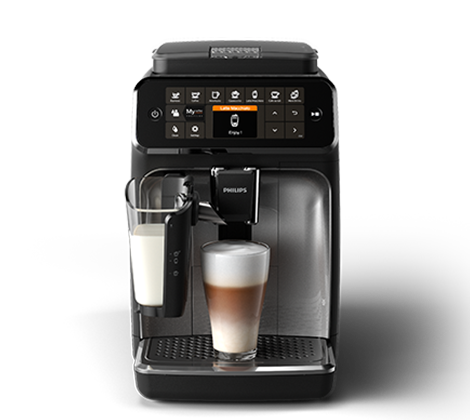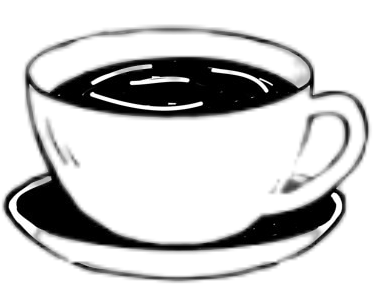#1: Philips 3200

- Easy to use
- Affordable
- Compact design
#2: Philips 4300

- More drink options
- Intuitive touchscreen
- Customizable settings
As a coffee enthusiast, I've had the pleasure of exploring various espresso machines, and today, I'd like to share my insights on two popular models from Philips: the 3200 and 4300 series. After extensive use and comparison, I've found that the Philips 4300 series stands out as the superior choice.

Design and Build Quality: Philips 3200 vs 4300
Both machines boast sleek, modern designs that complement any kitchen decor. The Philips 3200 series features a compact build, making it ideal for kitchens with limited counter space. Its intuitive interface includes a black-and-white touch display accompanied by physical buttons, ensuring user-friendly operation.
In contrast, the Philips 4300 series offers a slightly larger footprint but compensates with a more premium feel. It comes equipped with a color TFT display and touch-sensitive buttons, enhancing the user experience with a more interactive interface. The 4300 series also provides multiple finish options, including matte black and stainless steel, adding to its aesthetic appeal.
Brewing Technology and Coffee Quality
When it comes to brewing technology, both machines share several advanced features:
Aroma Extract System: This system optimizes the balance between brewing temperature and aroma extraction, resulting in a rich and flavorful cup of coffee.
Ceramic Grinder: Both models are equipped with durable ceramic grinders offering 12 adjustable grind settings, allowing customization of coffee grounds to suit individual preferences.
LatteGo Milk System: An innovative milk frothing system that creates smooth, creamy milk froth for cappuccinos and lattes. It's easy to clean, with only two dishwasher-safe parts and no tubes.
However, the Philips 4300 series has an edge with its ability to prepare five different coffee drinks, including espresso, coffee, cappuccino, latte macchiato, and americano. In comparison, the 3200 series offers four varieties, lacking the americano option.

Personal Experience with Brewing
From a personal standpoint, I've used both machines in my home for several weeks, and I can say the coffee quality is quite similar in terms of flavor. Whether you choose the Philips 3200 or the 4300, you will get a cup of coffee that tastes as though it came from a local café. However, the 4300 makes things just a bit easier and more flexible.
For instance, I enjoy having a good americano to start my morning, and the 4300's americano option quickly became a daily ritual for me. With the 3200, I needed to play around with different coffee-to-water ratios to get something similar. That’s where the 4300 shines—it takes the guesswork out of making more complicated drinks. The customization is right there on the display, with easy presets and tweaks that allow you to get what you want without a lot of fuss.
User Experience and Customization: Philips 3200 vs 4300
The user experience is where the Philips 4300 series truly shines. Its color TFT display and touch-sensitive buttons make navigation and customization straightforward. Users can easily adjust coffee strength, volume, and milk froth consistency to their liking. The machine also offers programmable settings, allowing for a personalized coffee experience.
The Philips 3200 series, while user-friendly, features a black-and-white touch display with physical buttons. It allows for customization of coffee strength, volume, and milk froth but lacks the programmable settings found in the 4300 series. As someone who enjoys experimenting with different coffee profiles, I appreciated the programmable user profiles on the 4300. I could easily save my favorite settings, making it quicker to get my ideal cup, especially in the morning when I’m still waking up.
Maintenance and Cleaning Considerations
I think it’s important to consider how much maintenance you’re willing to put into a coffee machine. Both the Philips 3200 and 4300 make maintenance relatively straightforward, and this is one of the reasons I lean toward recommending them to others.
The automatic cleaning cycles are a blessing, especially for those who drink multiple cups a day, like myself. The LatteGo milk system, which both models share, is the easiest milk system I’ve dealt with compared to other brands. With just two dishwasher-safe parts, there's no tube cleaning, which was always a hassle for me with previous espresso machines.
The removable brew group is another feature that adds to the machines’ appeal. You can take it out and rinse it under running water, which helps keep the brewing system clean without much fuss. I’ve noticed that the Philips 4300 slightly improves upon this process by reminding users when cleaning is due, which is something the 3200 model lacks.

Milk Frothing and Specialty Beverages
Another aspect worth mentioning is the milk frothing capabilities. Both the Philips 3200 and 4300 use the LatteGo milk system, which works incredibly well for preparing cappuccinos and lattes. I found the milk texture to be velvety and consistent, and the temperature was always just right. If you are someone who loves milk-based beverages, both machines are excellent.
However, what sets the 4300 apart is the variety of specialty beverages and the intuitive display. It takes just one or two button presses to create something more complex, like a latte macchiato. With the 3200, there is a slight learning curve, and you might find yourself fiddling with the options a bit more to get things just right.
Price and Value for Money: Philips 3200 vs 4300
When discussing price, I should mention that the Philips 4300 series is, naturally, a bit more expensive. However, after using both machines extensively, I feel the price difference is justified by the added features and overall convenience of the 4300.
If you value simplicity and versatility, the 4300 is an excellent choice. It’s the kind of machine that makes you look forward to making your morning coffee. The user profiles, additional drink options, and premium feel are things that I believe make it worth the extra cost. On the other hand, the 3200 still delivers a fantastic cup of coffee and would be more suitable for someone who doesn’t need all the bells and whistles but still appreciates a high-quality brew.
Final Thoughts on Choosing Between Philips 3200 and 4300
Ultimately, deciding between the Philips 3200 and 4300 comes down to your preferences and budget. Both machines are fantastic for making great coffee at home, but if I were to recommend one, I’d lean towards the 4300 for its added convenience and versatility.
For someone who is just getting into the world of espresso machines, the 3200 is a great starting point. It’s easy to use, delivers high-quality coffee, and doesn’t overwhelm with too many features. But if you’re like me and love having options at your fingertips, enjoy experimenting with different drinks, and want a machine that you can truly personalize, then the Philips 4300 is the way to go.
Product Review Conclusion: Philips 3200 vs 4300
In conclusion, while both the Philips 3200 and 4300 series offer excellent features and coffee quality, the 4300 series stands out as the superior choice. Its advanced brewing technology, enhanced user experience, and greater versatility make it a worthwhile investment for any coffee enthusiast seeking a high-quality, fully automatic espresso machine. It has everything you need to make a wide variety of beverages, and the intuitive controls make it simple to adjust to your liking.
Frequently Asked Questions
Q: What are the main differences between the Philips 3200 and 4300?
A: The main differences are in the variety of coffee drinks offered and the user experience. The Philips 4300 can prepare five coffee drinks, including an americano, whereas the 3200 offers four without the americano. The 4300 also has a color TFT display and programmable user profiles, which the 3200 lacks.
Q: Is the Philips 4300 worth the extra cost over the 3200?
A: If you value additional convenience, more customization options, and a premium interface, the 4300 is worth the extra cost. However, if you just want a straightforward, high-quality coffee machine without too many added features, the 3200 will serve you well.
Q: How easy is it to clean the Philips 3200 and 4300?
A: Both machines are relatively easy to clean. They come with automatic cleaning programs and removable brew groups. The LatteGo milk system is also very easy to maintain, with only two dishwasher-safe parts and no tubes to clean.
Q: Can I make a good americano with the Philips 3200?
A: Yes, you can make an americano with the Philips 3200, but it requires a bit of manual effort in adjusting the coffee-to-water ratio. The 4300 has a dedicated americano option, making it easier to prepare.
Q: Does the Philips 3200 have programmable user profiles?
A: No, the Philips 3200 does not have programmable user profiles. The 4300, however, allows users to save their preferred coffee settings, which adds convenience if multiple people use the machine or if you like to experiment with different profiles.
Q: Are both machines suitable for milk-based drinks like lattes and cappuccinos?
A: Yes, both machines are equipped with the LatteGo milk system, which produces velvety milk froth ideal for lattes and cappuccinos. The milk frothing performance is similar in both models, providing excellent results
